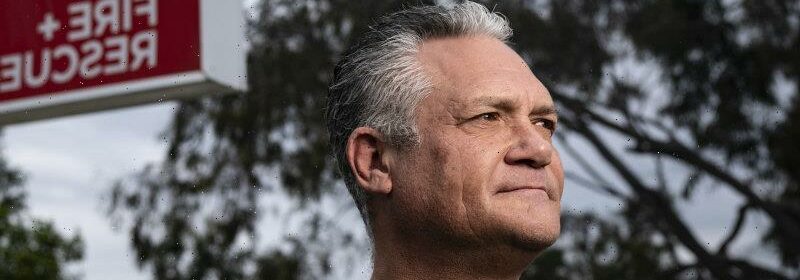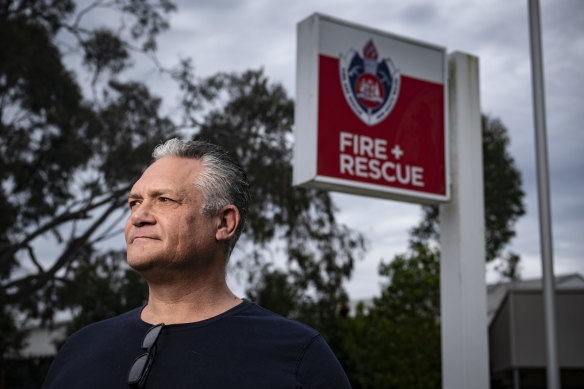‘My little brother is dead’: Ex-fire exec blasts firies’ failure to use life-saving equipment

The brother of a man who died next door to a fire station says the father of three might have had a better chance of surviving if NSW Fire and Rescue had signed up to a scheme allowing firefighters to respond to cardiac emergencies.
Bernard King, who worked for NSW Fire and Rescue (FRNSW) until last year, said his brother, a 48-year-old engineer, went into an apparent cardiac arrest in a music studio beside Windsor Fire Station last Saturday. King believes help arrived too late.
Fire and Rescue wants to sign up to NSW Ambulance’s Public Access Defibrillation (PAD) program, under which equipped and trained first responders such as firefighters can use devices that send a shock to the heart if the patient is unresponsive and an ambulance cannot get there quickly.
Bernard King outside Windsor Fire Station, near where his younger brother had a heart attack on Saturday.Credit:Wolter Peeters
However, the Fire Brigade Employees Union (FBEU) has resisted, saying its staff would need much more training and mental health support, as well as a salary increase of 12.5 per cent, to take on a different, traumatic and complex workload.
The Industrial Relations Commission recognised the “obvious community benefits” of the program but found it would constitute an extra claim that could not be facilitated under the award. It told the two parties to work together on a solution.
King, who led employee relations for FRNSW for a decade, sent an email to his former boss, Commissioner Paul Baxter, this week with the subject line “my little brother is dead”.
“When I worked with you, it remained an embarrassment to me that firefighters had not yet joined the community scheme PAD,” he said. “Worse, firefighters have resisted joining the ambulance scheme to co-respond to a tiny category of calls that ambulance could not respond to promptly, while holding out for a pay rise.
“Well, this reality has hit home in a terrible, personal way over the weekend. I am broken and disgusted. Fire and Rescue NSW cannot hold its head up in public when it refuses to save lives.”
King told the Herald he could not know if faster help would have saved his brother. But if the PAD scheme were working now, NSW Ambulance could have directed firefighters to the scene if it was concerned that its response time would be too long.
“[Firefighters] would have rocked up with a defib device and training in advanced first aid, and that might have easily been the difference between life and death for this 48-year-old,” he said. “I’m making a noise about this case because he’s my brother, but there have been hundreds [of similar cases] over the year.”
Ambulance logs show paramedics arrived 10 minutes after the call to emergency about King’s brother. Research shows first responders have only 10 minutes to positively impact an out-of-hospital heart attack.
Windsor is a so-called retained station, which means it is not staffed and relies upon on-call workers, who are required to live within a few minutes and respond immediately when they are paged. Staff were there when the Herald’s photographer was outside on Friday.
“Retained firefighters are typically recruited from within three kilometres of a station so they can arrive at the station within minutes,” King said. “Sometimes firefighters are at the station anyway for drills and admin and to use the gym.”
However, Leighton Drury, the state secretary of the FBEU, said introducing the PAD program would be complex. “It needs a lot of work,” he said. “Victorians [who have implemented the system] did that work, they get a lot more training, there is a lot more mental health support.
“None of that work has been done [in NSW] yet.” He said FRNSW proposed introducing PAD only to permanent metro stations, and not stations such as Windsor. There was already a program called Community First Responders, which responds to medical callouts in certain – mostly regional – areas.
“Obviously, the ambulance service needs to be better funded to address the problems we have within our health system,” Drury said.
A spokesman for FRNSW said it had not been able to reach an agreement with the FBEU on implementing PAD but was continuing talks. “Firefighters are properly equipped, trained and capable of delivering basic life support, CPR and defibrillation,” he said.
“This is a tragic situation, and our thoughts are with Bernard King and his family during this time.”
A NSW Health literature review on PAD – which involves a trained volunteer or first responder such as firefighters or police doing CPR and doing external defibrillation – found the program resulted in a two- to three-fold increase in survival.
It also found that so-called dual dispatch systems, involving trained first responders such as police or fire departments, shorten the time to defibrillation and increase its success, as well as improve rates of survival to hospital.
“In Australia, only Victoria have most components of the PAD program and have reported dramatic improvements in bystander CPR and [automated external defibrillator] use and in survival to hospital discharge after [a cardiac arrest outside hospital],” it said.
Ambulance response times have grown longer in the past five years. The state’s hospital report for January to March revealed about two-thirds of patients who needed a lights-and-sirens emergency response did not get an ambulance within the 15-minute benchmark.
The government will spend $1.76 billion on more paramedics and stations.
Our Breaking News Alert will notify you of significant breaking news when it happens. Get it here.
Most Viewed in National
From our partners
Source: Read Full Article
